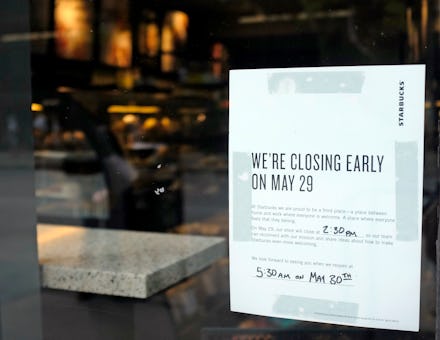Here’s the racial bias training Starbucks employees got Tuesday, according to its architects

Starbucks kept its promise to address racism in its ranks, closing 8,000 coffee shops nationwide Tuesday afternoon to educate roughly 175,000 employees on how to recognize and prevent racial bias.
The training was announced April 17 after two black men, Donte Robinson and Rashon Nelson, were arrested on suspicion of trespassing at a Philadelphia Starbucks a few days prior. An employee called police after the men declined to purchase anything until an associate they were waiting for arrived.
The incident sparked protests in Philadelphia, and a social media campaign urging customers to support black-owned coffee shops.
“The situation was reprehensible and does not represent our company’s mission and enduring values,” Starbucks executive chairman Howard Schultz said in a press release Tuesday.
Robinson and Nelson reached a settlement with Starbucks in May that involves the company distributing $200,000 to support young entrepreneurs.
The Perception Institute, which conducts research on implicit and explicit bias, and SY Partners, which works on human-led transformations for companies, co-created the curriculum Starbucks used to facilitate Tuesday’s 3 1/2-hour training sessions.
“We expect conversations are going to be heavy,” said Jen Randle, a principal at SYPartners, who is spearheading the implementation of the trainings for the products, in advance of the sessions.
Thirty experts across multiple science fields, including neuroscientists and racial inequity researchers, helped develop the training as well. According to Randle, participants broke into cohorts of three to five people for a series of group and individual exercises. Store managers participated alongside their employees.
No trainers nor moderators were present, but participants were given iPads with training videos and guidebooks directing them how to proceed. Starbucks also set up an 800 number that contacted a mediator trainees could dial if they got stuck, according to Randle.
The training officially began with employees exploring the differences in their identities with one another. Participants moved on to an exercise where they committed to providing a “third place” for Starbucks customers.
“The third place is a place between work and home,” Randle said. “It’s that community place. It’s the place where you feel you belong the most.”
For employees, Starbucks is not a “third place,” but a place of work. So trainees were asked to reflect on their own third place — perhaps a barbershop or a church — to think about how that place allows them to show up as their authentic selves.
“From there we want them to bring that feeling back into the experience of serving the costumer itself,” Randle said.
The third section of the training focused on bias. Participants were shown a video of Starbucks board member Mellody L. Hobson, the Perception Institute’s Alexis McGill-Johnson and Rachel D. Godsil and a Starbucks store manager from Oakland, California, in a roundtable discussion outlining what bias is and how it shows up in day-to-day life.
“We measure bias through an implicit association test and we help build out a way to sequence that conversation through a set of exercises,” said McGill-Johnson, who is the Institute’s executive director. The implicit association bias test was created in 1995 by University of Washington professor Anthony G. Greenwald to measure unconscious bias.
Armed with a working definition of bias, trainees moved on to an exercise where they reflected on their own racial identities. They were prompted to think about how they typically respond to interactions involving persons of a different race — making eye contact, for instance. They then shared their reflections with another person in their group.
In the next section, participants watched Stanley Nelson’s documentary You’re Welcome, an eight-minute short film exploring how black Americans have experienced racism in public accommodations from the 1960s to the present, Randle said.
Employees also learned about Starbucks’ recent amendment to its store policy, which now states that anyone who enters one of the company’s establishments will be considered a customer whether or not they make a purchase. Employees then committed to 12 more months of ongoing conversations and training, which will occur monthly.
A leadership conference for store managers and employees in higher-up positions was also scheduled to be announced Tuesday, Randle said. The conference will take place in a year and provide spaces for further conversations about race and bias.
Associates were then given time to think about the customers in the neighborhoods they serve and the barriers they face to creating a welcoming space for them. They then listened to audio clips of employees discussing times they exhibited bias against customers in their stores.
In one clip, a barista described hiding the tip jar when he saw a group of black men enter his shop because there had been thefts in the area. The barista realized his bias after one of the black men asked for the jar so he could tip a dollar because he really impressed with his experience, said Randle.
“[Trainees are] asked, ‘If you have this experience how would you handle it differently?’” Randle explained. “They’re given a new mental model or new way of thinking to help them unpack that moment.”
After this final activity, employees were encouraged to reflect and share parts of their conversations with friends, families and communities.
According to McGill-Johnson, Tuesday’s training was not meant to eliminate all bias in a single session, but rather to provide an opportunity for employees to have more open conversations on the subject.
“That’s something Starbucks has to think through,” McGill-Johnson said, regarding eliminating bias outright. “They want to get through this day first and consider how to measure and build out a set of [actions] going forth. It’s really about the awareness building.”
May 30, 2018, 3:51 p.m.: This post has been updated.